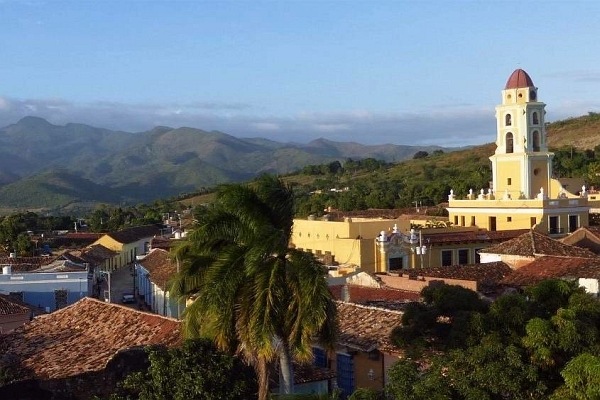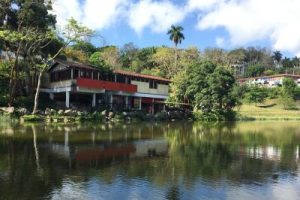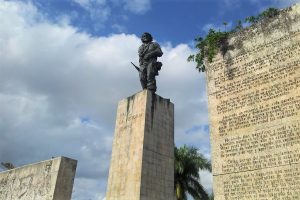Travel Guide

Travel Guide
Beaches, Cities & Sights in Cuba

The Cuban archipelago extends over an area of about 1200 km with about three times the coastline length. While the north coast is often rocky, the south coast is flatter and partly marshy. But, don't worry: Both coasts have a variety of beautiful sandy beaches!
The administrative territory of Cuba is divided into 15 provinces, which are administered from provincial capitals. According to their geographical location, five provinces can be categorized into the three regions of Western, Central and Eastern Cuba, whereby each region has a unique character.
Highlights:
★ The vibrant capital »Havana«
★ Caribbean dream beaches »Varadero«
★ Natural World Heritage »Viñales« & »Las Terrazas«
★ World Heritage Sites »Trinidad« & »Cienfuegos«
★ Caribbean beats in »Santiago de Cuba«
Cuba in a nutshell:
Population: 11 mio
Capital: Havana
Language: Spanish
National holiday: January 1st
Currency: Peso Cubano
Population: 65% European
Compulsory education: 9 years
National tree: royal palm (palma real)
National bird: red-blue-white tocororo (trogons)
Tourists: >4 million (2019)
The west of the island includes the provinces of Pinar del Rio, Artemisa, Mayabque, Havana and Matanzas.
The center of the Cuban archipelago is formed by the provinces of Cienfuegos, Villa Clara, Sancti Spíritus, Ciego de Ávila and Camagüey.
The eastern part of the island includes the provinces of Las Tunas, Holguín, Granma, Santiago de Cuba and Guantánamo.
In all three regions there is a large mountain range and a great number of interesting sights.
Western Cuba
The west of the country is the most important part of Cuba, which also has the highest tourist interest.
In the far west, in the province of Pinar del Rio, there are two natural World Heritage Sites. These include the Viñales Valley, which is particularly popular among tourists, and the Las Terrazas & Soroa Biosphere Reserves, embedded in a charming landscape. Not only nature lovers will find these resorts definitely worth a visit.
Slightly east of these attractions lies the vibrant city of Havana, which is the undisputed political, cultural and economic center of the country. Havana offers visitors a variety of exciting sights, with Havana's historic city center undoubtedly being one of the most significant attractions and a must-see when traveling around Cuba.
About two hours' drive west of the capital lies the popular Varadero resort on a peninsula. With well over a million annual visitors, the Cuban Miami Beach is by far the most frequently visited bathing and vacation paradise on the entire island.
Central Cuba Highlights:
★ Historic towns of »Cienfuegos«, »Camagüey« & »Trinidad«
★ Tropical mountain landscape »Sierra del Escambray«
★ Paradise beaches »Cayo Santa Maria« & »Cayo Coco«
Central Cuba
The green center of the island is dominated by seemingly endless sugar cane fields. The main attractions include four important cities: In Santa Clara, the last great battle of the Cuban Revolution was decided. After the victory of the revolution, the city erects an imposing monument to the commander and internationally known revolutionary "Che".
Other attractions of central Cuba are the historic old towns of Cienfuegos and Camagüey and, of course, the particularly popular colonial town of Trinidad, all three of which are UNESCO World Heritage Sites.
Nature lovers will find untouched nature in fascinating landscapes in the mountain ranges of the Sierra del Escambray.
Along the north coast there are two offshore island groups, Cayo Santa Maria & Cayo Coco, which offer fantastic Caribbean beaches. On the south coast of central Cuba, Trinidad, and Cienfuegos also have very beautiful sandy beaches to offer.
Eastern Cuba Highlights:
★ Cuba's second largest city»Santiago de Cuba«
★ tropical nature paradise »Baracoa« im tiefsten Osten
★ Cuba's second most important seaside resort »Guardalavaca«
Eastern Cuba
The east of the island, known as Oriente, is home to the wildest part of Cuba. In the east, the African roots of the population are much more present than in the rest of the country. This also explains why several independence movements originated here. A large part of the region is dominated by the Sierra Maestra mountain range, which is also home to Cuba's highest mountain, the Pico Turquino, which rises to almost 2000 m above sea level. To the north and west of the southern tip, the deep valleys and high mountains merge into flat land. North of the mountains is the city of Holguín, which is close to Cuba secod most important vacation heaven of Guardalavaca. In the center of the southern coastline encircled by the Sierra Maestra lies Santiago de Cuba, the capital of the Oriente. In the far east, one can explore the provincial capital of Guantánamo and the tropical natural paradise of Baracoa.
Discover the regions

















